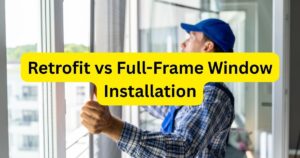Not sure whether your windows need a simple fix or a full overhaul? You’re not alone.
Choosing between full-frame vs glass insert replacement can feel overwhelming — especially when you’re trying to balance budget, time, and long-term results.
Full-frame window replacement is the better choice when frames are damaged, insulation is poor, or you’re doing a full renovation. Glass insert replacement is ideal when the existing frame is solid and you’re looking for a quicker, less invasive upgrade or the glass is damaged.
In this guide, we’ll break down the key differences between full-frame and insert window replacement, including cost, installation time, energy efficiency, resale value, and so on. So, read along!
A Quick Comparison Table Between Full-Frame vs Glass Insert Replacement
Before going into a comprehensive comparison, take a quick look at the following table to get a brief idea about their primary differences:
| Full-Frame Replacement | Insert Replacement |
| Replaces entire frame and trim | Fits into existing frame |
| Ideal for damaged, warped, or aging frames | Best for solid, square, leak-free frames |
| Takes longer to install | Faster install |
| More disruptive, may involve drywall or siding work | Minimal disruption, no major construction |
| Higher cost due to extra labor and materials | More budget-friendly option |
| Offers better insulation and sealing | Good efficiency if frame is in top condition |
| Fully customizable with new trim and finishes | Preserves existing trim; slightly less glass area |
| Allows inspection and repair of hidden damage | Structure remains hidden behind old frame |
| Seen as a full upgrade by homebuyers and inspectors | Adds value but may raise questions if frames are old |
What Do Full-Frame and Glass Insert Mean?
Full-frame window replacement means everything comes out — the old window, frame, trim, and sometimes even the insulation around it.
It’s a full tear-out down to the studs, giving you a clean slate and better sealing. This method lets you fix any hidden damage, adjust the size, and improve insulation from the ground up.
On the other hand, glass insert window replacement (also called pocket replacement) keeps the existing frame.
A new glass panel is fitted inside the old frame — kind of like sliding a new drawer into an old cabinet. It’s faster, cheaper, and less invasive, but only works if the original frame is still solid and square.
When Full-Frame Window Replacement is the Better Choice?
If you’re looking for a complete reset — not just a quick fix — full-frame window replacement is the way to go. Here’s when full-frame clearly wins:
Your Window Frames Are Damaged, Warped, or Out of Square
If your window frames are rotting, warped, cracked, or just don’t sit square in the wall anymore, full-frame is the only logical move.
Insert windows rely on the structural integrity of that existing frame — if it’s compromised, the new window won’t seal right. You’ll end up with drafts, leaks, and eventually, more repairs.
Full-frame removes all the damaged parts and rebuilds from the studs — clean and solid.
You’re Dealing with Drafts, Condensation, or Energy Loss
If you’re feeling cold air creeping in or noticing condensation between the panes, there’s a good chance your window system isn’t sealed properly — and the issue might go deeper than just the sash.
Full-frame replacement lets you access and improve insulation, flashing, and air sealing around the opening. That’s how you actually solve energy loss — not just mask it.
You’re Renovating the Exterior or Updating Siding
If you’re already planning a siding job, adding stone veneer, or reworking the exterior trim, full-frame is a no-brainer. Since the exterior is already being touched, there’s zero reason to leave an old window frame in place.
Doing both together not only saves labor in the long run but ensures the entire envelope is built and sealed correctly — as one system.
You Want to Maximize Resale Value and Long-Term ROI
Full-frame replacements send a message to potential buyers: nothing was cut short. They see a full renovation, not a surface-level update.
That builds trust — and helps you stand out in the market. Add in better energy ratings and fewer long-term issues, and full-frame becomes an investment, not just a fix.
When Glass Insert Replacement is the Better Choice
If your windows are showing their age or damage but the frames themselves are still solid, insert window replacement is a fast, practical way. Here’s when insert wins:
Your Window Frames Are Still in Excellent Condition
Insert replacements only work if the existing window frame is structurally sound, level, and free from moisture or rot.
If you press on the frame and there’s no softness, no cracks, and no shifting, you’re in a good spot. There’s no point in tearing out a perfectly fine frame just to start over — especially if you’re not seeing leaks or draft issues.
Insert windows let you keep the strong foundation in place and simply slide in a modern, energy-efficient window without the extra work or cost.
You Want to Avoid a Messy, Invasive Project
Not everyone wants their home turned into a construction site. Insert replacement is much cleaner than full-frame.
The installer doesn’t need to rip out drywall, touch your siding, or rebuild interior trim. There’s no sawdust coating your furniture, no walls open to the outside, and no need to schedule around days of construction.
Most jobs can be done in a day or two with minimal prep. If you’ve got kids, pets, or a packed schedule, insert keeps life moving without disruption.
You’re Working Within a Budget
When you’re replacing multiple windows, labor, and materials add up fast — and insert window replacements help keep things in check.
Since you’re not removing and replacing the frame, trim, insulation, or wall materials, the scope of work (and the bill) stays smaller.
It’s one of the most cost-effective ways to improve your home’s energy performance and appearance without blowing up your renovation budget.
And if your windows are standard sizes, it’s even easier to stay on budget with off-the-shelf insert units.
You’re Focused on a Visual or Efficiency Upgrade
Not all window projects are about fixing major issues. Sometimes you just want a cleaner look, better noise reduction, or to finally get rid of those foggy or cracked panes. Insert replacement is perfect for that.
You get updated aesthetics, improved thermal performance, and options like double- or triple-pane glass — all while leaving the bones of your window intact.
They’re ideal when your goal is comfort and style, not structural overhaul.
Full-Frame vs Glass Insert Replacement: Additional Side-by-Side Comparison
When you’re choosing between full-frame and insert window replacement, it’s not just about which one is “better.” Here are some additional comparisons:
Cost Breakdown
Full-frame replacements are more expensive — not just because of the window unit, but because you’re replacing the entire frame, trim, insulation, and potentially fixing any hidden issues.
Labor costs go up, especially if wall repairs or exterior finishing are involved.
Insert windows, on the other hand, use the existing frame, so there’s less material and faster install time. It’s a more affordable solution, especially for homes with many windows — but only if the frame underneath doesn’t need work.
Installation Time & Disruption
Insert window replacement is much quicker — often 1 to 2 days for a full house, and with far less disruption. No drywall mess, no siding removal, no heavy demo. You can live in the home comfortably during installation.
Full-frame installation takes longer — typically up to 5 days depending on how many windows you’re replacing and whether framing repairs are needed.
Expect more noise, dust, and areas of your home to be temporarily off-limits.
Energy Efficiency
Full-frame wins when it comes to energy efficiency. Since you’re removing the entire unit, you can fully reseal, insulate, and weatherproof the window opening. This reduces drafts, moisture intrusion, and thermal loss.
Insert windows can still improve efficiency, but they rely on the existing frame’s condition. If that frame has gaps, damage, or poor insulation — the new insert won’t fix that.
If you’ve got cold spots, air leaks, or moisture issues, go full-frame. If the frame is solid and you’re upgrading from single-pane, insert replacement might be enough.
Curb Appeal & Interior Look
Insert windows slightly reduce the visible glass area because the new window fits inside the old frame. It’s not always noticeable, but in smaller or older windows, it can feel a bit more boxed-in.
Full-frame windows allow full custom sizing, new trim, and a more seamless look — both inside and out.
You can align your window perfectly with new siding or interior finishes, which makes a big difference in how the upgrade looks from the curb and from inside your home.
Bonus: Full-frame gives you a clean, uniform look across all windows — great for design consistency during a larger remodel.
Structural Access & Inspection
The full-frame installation opens up the entire wall cavity. That means your contractor can see everything — insulation, studs, framing, potential rot, mold, or pest damage — and deal with it on the spot.
Insert replacements don’t expose any of this. If there’s hidden damage, it stays hidden. You’re relying entirely on visible signs and surface-level assumptions.
If your home is older or has a history of leaks, full-frame replacement gives you peace of mind — not just a prettier window.
Resale Value
Full-frame windows tend to boost resale value more because they’re a full system upgrade. Inspectors love them. Buyers see them as a sign of a thorough renovation, not a shortcut.
Insert windows are still valuable but may raise questions if the frames are clearly aging or mismatched. A buyer might wonder what’s lurking behind that updated glass.
If you’re planning to sell soon — especially in a competitive market — full-frame installs are often seen as the higher-quality choice that helps your home stand out.
How to Decide Which One to Pick Between Full-Frame vs Insert Window Replacement
By now, you know both options have their place. When it comes to your home, you want a clear, confident decision. It’s about knowing what to look for and matching the right method. Here are some factors to consider while picking one:
| Decision Factor | Full-Frame Window Replacement | Glass Insert Replacement |
| Frame Condition | Frames are damaged, rotted, or out of square | Frames are solid, square, and in good shape |
| Air Leaks/Moisture | Drafts, condensation, or poor insulation are present | No signs of air leaks or water damage |
| Exterior Renovation | You’re replacing siding, trim, or doing exterior remodeling | You want to leave siding and trim untouched |
| Project Scope | Full upgrade with insulation, flashing, and sealing | Minimal work — keeping structure as it is |
| Energy Efficiency Goals | Maximum performance and airtight sealing | Moderate efficiency improvement with lower investment |
| Budget | Higher cost, more materials and labor | Budget-friendly and cost-effective |
| Disruption Level | More time, mess, and prep work (drywall, siding, trim) | Quick install, minimal disruption |
| Aesthetic Goals | Complete customization, fresh trim, seamless finish | Keeps current trim; slight reduction in glass area |
Conclusion
To wrap it up, Full-Frame vs Insert Window Replacement isn’t just a technical choice — it’s about what’s right for your home long-term. If your frames are damaged or you’re aiming for a full upgrade, go full-frame.
In case they’re solid and you want a clean, efficient update, insert is the smarter route. Take a good look at your frames, your goals, and your budget. The right call now saves money, boosts comfort, and prevents regrets down the line.



